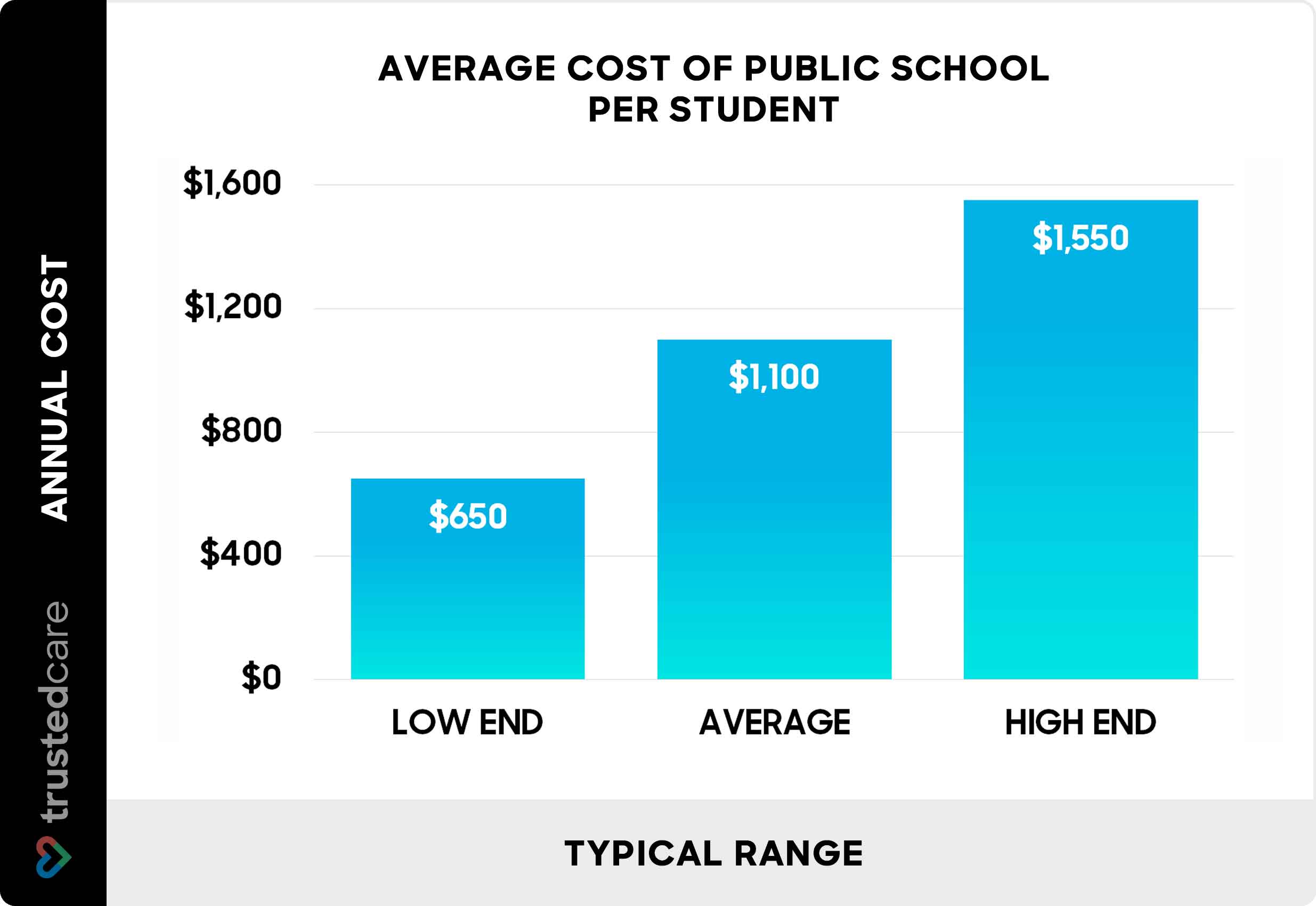
How much does public school cost
How much does public school cost
$650 – $1,550 average cost per student, per school year
Average cost of public school per student
The average cost of public school is $650 to $1,550 per student, per school year when counting extra costs for transportation, school supplies, daily school lunches, and technology fees. Public school is free for students who qualify for free transportation, lunches, basic school supplies, and technology.

| National Average Cost | $1,100 |
| Minimum Cost | $50 |
| Maximum Cost | $3,000 |
| Average Range | $650 to $1,550 |
Public school costs
While public education is free in the United States, families may spend $650 to $1,550 per student per school year on other costs associated with attending public schools. These costs include transportation, school supplies, and daily school lunches.
Other optional expenses—including field trips, yearbooks, and extracurricular activities—can bring the total cost up to $1,200 to $3,000 per student each school year.
| Factor | Average cost per student (per school year) |
|---|---|
| Required expenses: | |
| Tuition & books | Free |
| Transportation | Free – $350 |
| School lunches | $500 – $550 |
| School supplies | $50 – $300 |
| Technology fees | $100 – $350 |
| Optional expenses: | |
| Field trips | $20 – $300 |
| Extracurricular activities (clubs & sports) | $500 – $1,000 |
| Yearbook | $50 – $100 |
| Total annual cost: | |
| Total cost for required expenses only | $650 – $1,550 |
| Total cost including optional expenses | $1,220 – $2,950 |

Tuition & books
Public schools do not charge tuition. The school often provides textbooks, but there may be instances where students need to purchase their own books or instructional materials. In recent years, some schools have implemented digital textbooks, reducing the need for physical copies.
Transportation
Public school transportation is not always free, with some districts charging $0.50 to $1.00 per ride. In many cases, bus services are only provided for students who live a certain distance from the school. Some districts offer paid transportation services for all students, even those within walking distance.
After-school transportation costs $8 to $50 per trip for pickup and drop-off services that transport students to after-school activities.
School lunches
The average cost of school lunch is $2.75 to $3.00 per day, depending on your school district. If your student pays for school lunch on most school days, you will likely spend $500 to $550 over the 36-week school year.
For families that choose to pack a lunch for their students, plan to budget $2 to $5 per student for a lunch that includes a sandwich, fruit or vegetables, snacks, and a beverage. Including organic, fresh, and brand-name products will increase your bagged lunch costs.
School supplies
On average, parents in the United States spend from $50 to $200+ per child, per year on school supplies such as backpacks, notebooks, pencils, pens, binders, folders, and other basic supplies. Costs may be higher for middle and high school students who need additional supplies or specialized equipment.
Technology fees
Public school technology costs vary depending on the student’s age and school district, but families can expect to spend $100 to $350 per year, not including a laptop or tablet which can cost $50 to $1,500 more.
While many school districts provide free computer devices to make technology accessible to all students, parents should budget for additional technology costs, including:
Internet access – Students usually need reliable internet access at home, costing $50 to $100 per month, to complete assignments and access learning resources.
Tech insurance – Many schools require parents to purchase insurance costing $10 to $50 per school year for devices provided by the district.
Software and apps – Students may need to purchase specific software or apps for their school work with varying costs, depending on the program.
Printing and copying – Students may need to print or copy documents for school assignments. Costs for a printer, ink, and paper can add up to $40 to $200 per school year.
Optional expenses
Parents should budget $25 to $100 per year for field trips for elementary-age students and as much as $150 to $300 per year for middle and high school students. While field trips are not usually mandatory, they contribute to student learning and engagement.
Extracurricular activities such as sports, clubs, and lessons add up to $500 to $1,000+ per year for each child. Sports tend to be the most expensive, followed by arts and then clubs. Travel, equipment, and competition fees significantly drive up costs.
Cost of public school vs. homeschooling
Many parents elect to homeschool their children, rather than send them to public school. Homeschooling a child costs $700 to $2,800 annually, including books and curriculum materials, school supplies, field trips, and extracurricular activities, such as sports and art classes.
For parents who work or feel unable to teach their children, hiring a private homeschool teacher costs $1,300 to $7,600 per month to manage the entire planning and teaching process. You can save nearly half the cost by collaboratively sharing the cost of a private teacher with another family.
Cost of public school vs. private school
Another alternative to public school, private school costs $10,000 to $20,000 per year for day school tuition, books, uniforms, and other costs. Private school tuition prices depend on the school type, location, facilities, and the child’s education level.

Cost of public school vs. Montessori school
Montessori school costs $12,000 to $18,000 per year for tuition, plus $200 to $2,500 per year for school materials, supplies, and activity fees. Montessori schools emphasize self-directed activity and hands-on learning with the goal of instilling a love of learning rather than relying on grades for motivation.
Public school cost FAQs
Do public schools cost money?
In the US, public schools are funded through local, state, and federal taxes. As a result, residents in each school district do not pay tuition to attend public schools. Public education is considered a right for all residents. However, fees apply for certain activities, supplies, or extracurricular programs.
Do public charter schools cost money?
Public charter schools in the United States are publicly funded schools, which means they do not charge tuition. Like traditional public schools, charter schools are financed by taxpayers and operate under the oversight of government authorities, typically at the state level.
Do private schools cost more than public schools?
Yes, private schools cost more than public schools. Unlike public schools which are mostly free for students, private schools cost $10,000 to $20,000 per student per year.
How to save on public school costs
Public schools in the US are funded through taxes, and students do not have to pay tuition to attend. However, the additional costs associated with public schools such as school supplies and extracurricular activities can add up. Some tips for saving on these expenses include:
Rely on the basic school supplies that most public schools offer including free textbooks, notebooks, and pencils.
Participate in free or low-cost programs at your local school or community center, rather than paid clubs or sports.
If the school does not provide transportation from your home, consider carpooling with other families to reduce your transportation costs.
Look into financial assistance programs that may be available in your area to cover the costs of field trips and other school-related expenses.
Take advantage of back-to-school sales and bulk purchasing when shopping for school supplies.
If eligible, use the free or reduced-price lunch programs offered by public schools to reduce daily expenses associated with providing lunch for your child.
Consider buying secondhand items such as backpacks, clothing, and sports equipment.
Participate in parent volunteer programs that may offer discounts on certain fees or activities.
Communicate with teachers and school staff if you are facing financial challenges. They may be aware of resources or assistance programs to help.
Create a budget for school-related expenses to manage costs more effectively.